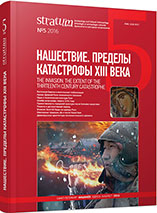После катастрофы: Киев в 1241 г.
Catastrophe: the Aftermath. Kiev in 1241
Author(s): Glib Yu. Ivakin, Oleksii V. KomarSubject(s): History, Archaeology, Middle Ages, 13th to 14th Centuries
Published by: Издательский дом Stratum, Университет «Высшая антропологическая школа»
Keywords: Old Rus’; Kiev; 13th century; Mongol invasion; mass burials
Summary/Abstract: The authors use archaeological data to examine the stages of inhumations of Kiev inhabitants killed in December 1240 after the seizure of the city by the Mongols. Differences in skeletons preservation and anatomical order in mass graves makes it possible to distinguish four groups of mass burials and four stages of cleaning the city from the bodies. Group I died in fires in buildings directly on the place of burial in December 1240. Group II — full anatomical order of skeletons buried in winter 1240/1241. Group III — incomplete skeletons or partial distortions of anatomical order, buried in the spring of 1241. Group IV — scattered disjointed bones and body parts buried within 5—7 months after their death (in summer 1241).Only a small part of the victims was buried at stages I—II in winter 1240/1241. Whereas most of mass graves contained various distortions in the order and anatomical integrity of skeletons, i. e. the main cleaning activities occurred in the city in the spring and summer of 1241. As a result, the area of Podil (Lower Town) was completely cleared from the dead bodies, while the former center of the city on the Old Kiev Hill turned into a huge graveyard of thousands of people and, therefore, was not used for residential development for a long time.
Journal: Stratum plus. Археология и культурная антропология
- Issue Year: 2016
- Issue No: 5
- Page Range: 59-72
- Page Count: 14
- Language: Russian
- Content File-PDF

